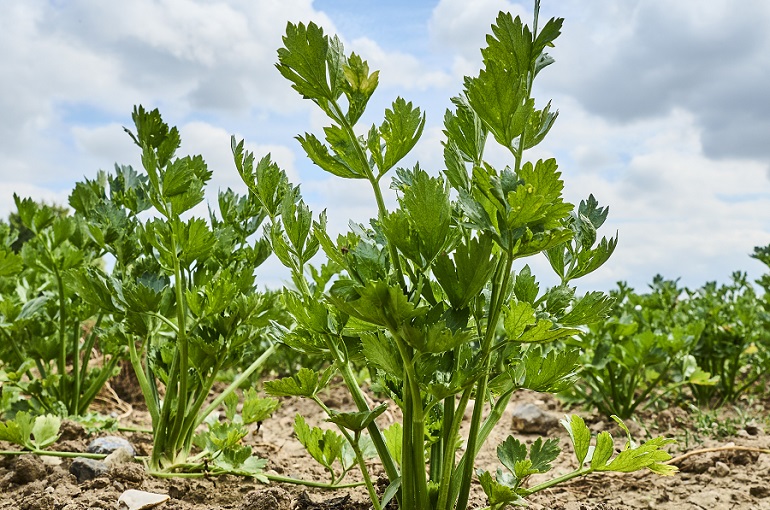Celery Soil preparation, Soil requirements, and Seeding requirements

This post is also available in:
This post is also available in:
![]() Deutsch (German)
Deutsch (German) ![]() हिन्दी (Hindi)
हिन्दी (Hindi) ![]() Ελληνικά (Greek)
Ελληνικά (Greek)
Note: the following information is for Apium graveolens var. graveolens (Celery).
Soil requirements and preparation
Celery is not very demanding regarding soil. However, the plants produce higher yields when cultivated in rich, medium to light soils with proper drainage, sufficient moisture, and a neutral pH (6.5-7.5). In acidic soils, where the pH is below 4, you may incorporate 2.5 tonnes of dolomite per hectare into the ground at least 5 months before sowing or transplanting (ask your local licensed agronomist). Heavy clay soils should be avoided.
The basic soil preparation starts a few weeks before sowing or transplanting celery seedlings. Farmers remove any previous crop residues and weeds and plow well at that time. Plowing improves soil aeration and drainage. At the same time, plowing removes rocks and other undesirable materials from the soil. A few days later, if the soil has proper moisture levels, they till the land. It is essential to leave the soil finely tilled without any big combined lump, which will most probably cause problems with cultivars rooting (mainly for varieties grown for their roots).
In most cases, farmers apply a basal fertilizer such as well-rotted manure or synthetic commercial fertilizer (90 grams per square meter of a high potassium general, granular fertilizer) after performing a soil analysis and consulting a local licensed agronomist. To enrich the soil and boost the establishment and growth of the plants, many growers apply 30 tonnes of well-rotted manure per hectare. If the farmer wants to cultivate organically, he/she should only use manure-compost from livestock grown organically or products certified for organic farming.
After that, probably the right time to install the drip irrigation pipes. Following the installation, in fields with a known history of soil-born diseases, some conventional farmers may apply soil disinfection substances through the irrigation system (ask a licensed agronomist in your area). In many cases, celery growers prefer to plant the seedlings on raised beds to facilitate root development (for root-cultivated varieties) and harvest.
Celery Planting and Plant Distances
Celery cultivation starts with (certified) seeds that depending on the environmental conditions, can either be directly sowed on the field or indoors and transplanted from the end of winter until the end of summer. In either case, all preparation steps (plowing, basal fertilization, installation of the irrigation system) need to be completed beforehand (before sowing or transplanting). Farmers that use self-harvested seeds are advised to treat them with hot water (30 minutes in 50 °C, or 122 °F) to disinfect them (from Septoria) and dry them soon after. Alternatively, many prefer to purchase celery seedlings ready for transplanting from a plant nursery.
Direct sowing is not a very popular method for starting a celery crop and is mainly used by amateur growers or in areas with warmer climates. In this case, the grower can start sowing outdoors during late winter or early spring, depending on the climate conditions of their location. Most use pneumatic seeding machines which spread the seeds on top of raised beds in rows 30-45 cm (12-18 in) apart and cover them with a soil layer of 0.5cm (¼ inch). Farmers use, on average, 1.25 – 2.5 kg of Celery seeds per hectare (2.6 – 5.2 lbs). When the plants have reached around 15cm in height, the growers may need to pass over the field and perform some thinning. This is more important in winter planting to minimize the risk of fungal infections. However, the plants may become more open than desired.
In the second case, farmers or professionals working in plant nurseries sow the seeds (50 grams per bed) indoors in a protective environment (tunnel or greenhouse), on seed beds (8 x 1.25 m) or trays covered with turf or/and vermiculite. Celery seeds sprout approximately 18-25 days after sowing. If the grower produces his/her own plants from seeds, it is important to keep them at a temperature of 16-21 °C (61-70 °F) and harden them off by stopping watering them 7-10 days before transplanting. The optimum stage for transplanting is when the plantlets have developed 4 leaves (10 to 12 cm or 4-5 in tall), and the last frost has passed. Farmers are advised not to plant too late in areas with high summer temperatures.
As for the planting distances, they are different depending on the cultivars. For varieties grown for their leaves and stalks, producers keep, on average, 30-40 cm (12-15.7 inches) distance between rows and 15-25 cm (6-9.8 inches) distance between plants in the row. For green and self-blanching celery varieties, closer distances should be preferred so the plants shade each other and blanching is facilitated. While for varieties cultivated for their roots, on the other hand, producers keep on average 30-40 cm (12-15.7 inch) distance between rows and 30-40 cm (12-15.7 inch) distance between plants in the row. On average, an optimum final plant density is around 70,000 -134,000 celery plants per hectare (28,350 – 54,270 plants per acre). Planting is done either by hand or with a mechanical planter.
If celery is rotated with other (not closely related) crops during the growing season, it can be cultivated in the same field yearly without having any negative impact (e.g., building up of diseases or yield drop).
References
https://agritech.tnau.ac.in/horticulture/horti_vegetables_celery.html
https://www.gov.nl.ca/ffa/files/agrifoods-plants-pdf-celery.pdf
https://www.rhs.org.uk/vegetables/celery/grow-your-own
https://southafrica.co.za/celery-planting.html
http://ipm.ucanr.edu/PMG/r104700111.html
Further reading
Interesting Facts, Nutritional Value and Plant Information of Celery
How to Grow Celery in a Pot in your garden
Growing Celery for Profit – Commercial Celery Farming
Celery Soil preparation, Soil requirements, and Seeding requirements
Celery Water Requirements – How to irrigate Celery
Celery Fertilizer Requirements









































































